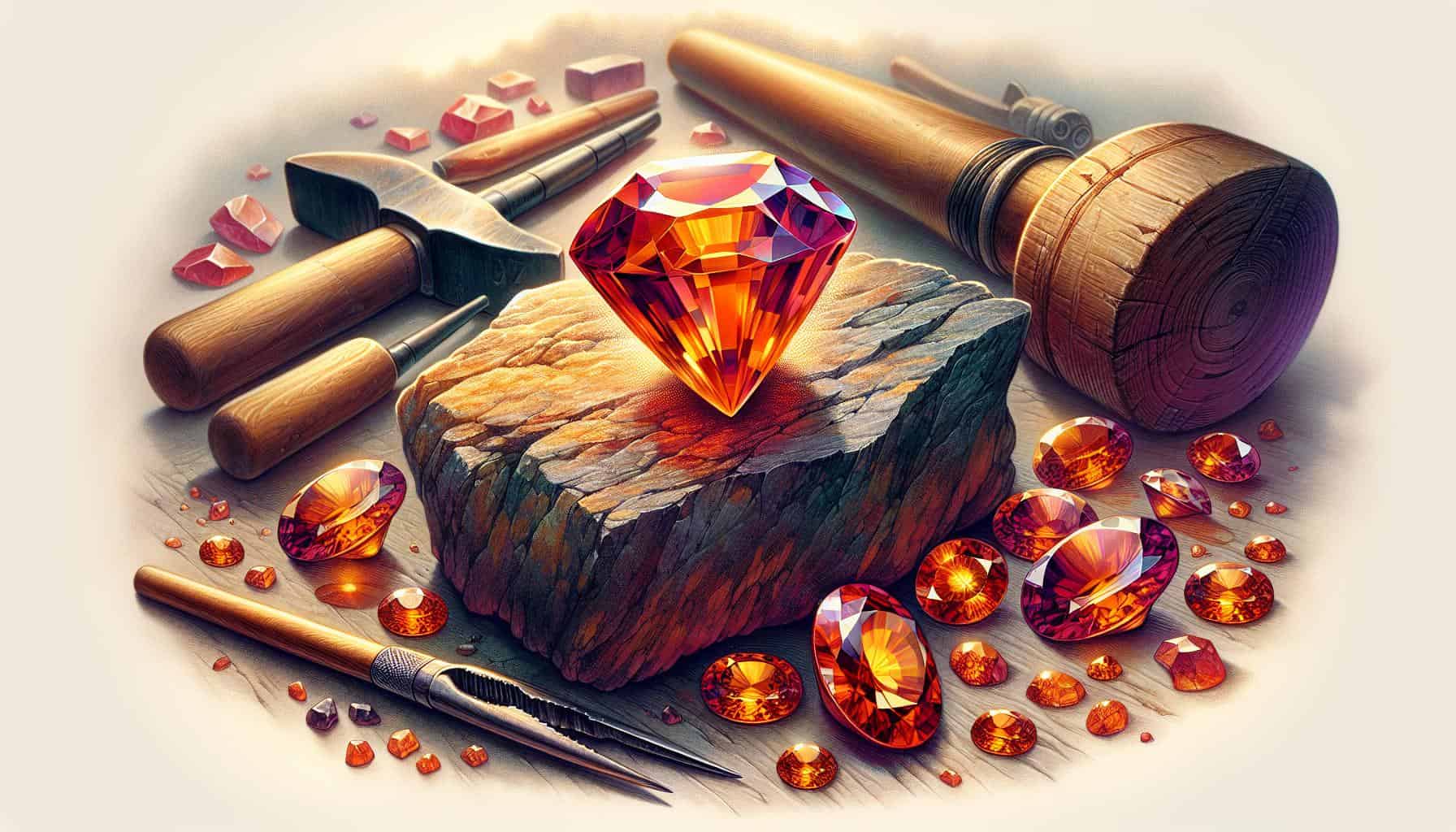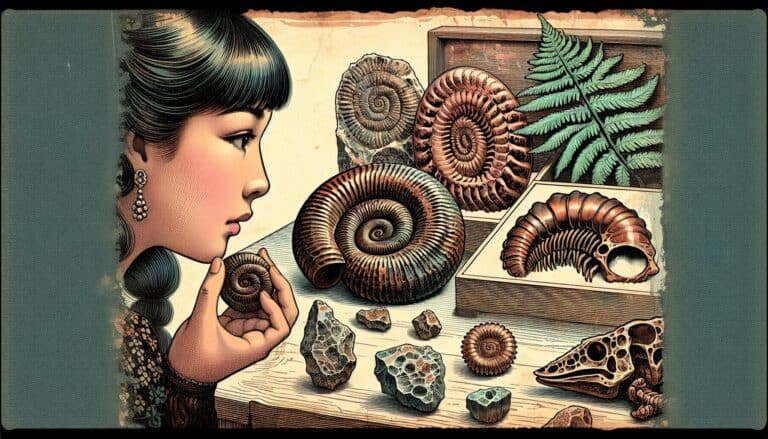Discovering the vibrant world of gemstones can be as thrilling as unearthing a hidden treasure.
You’re on the hunt for spessartite garnet, a gemstone celebrated for its fiery orange hues. But with so many stones out there, how do you pinpoint this particular gem?
Fear not, because identifying spessartite garnet is not as daunting as it might seem. With the right knowledge, you’ll be spotting these gems like a seasoned pro.
Let’s dive into the key characteristics that set spessartite garnet apart from the rest.
To identify real spessartite garnet, look for its vibrant “fanta orange” color, white streak on porcelain, and non-magnetic nature. It has a Mohs hardness of 7-7.5, can scratch glass, and shows no birefringence. Its specific gravity ranges between 3.6-4.1, aiding in verification.
How to Identify Spessartite Garnet Through Testing
Visual Inspection
Start with the basics. Hold the stone under good lighting and examine its color. Spessartite garnet typically displays an intense orange hue, often referred to as “fanta orange.” The stone should exhibit a transparent to translucent quality. Look for any inclusions, as these can provide clues to authenticity; spessartite garnet can have some, but they’re usually not visible without magnification.
The Streak Test
This test involves dragging the gem across an unglazed porcelain tile to observe the color of the streak it leaves behind. Spessartite garnet should leave a white or colorless streak, which indicates its nonferrous nature. If the streak shows color, it’s likely not a genuine spessartite.
Magnet Test
Spessartite can exhibit magnetic properties due to manganese content. Use a strong magnet to test the stone. If there’s a slight pull, it could be spessartite. However, it’s not conclusive since other minerals also respond to magnets.
Hardness Test
Garnets rank around 7 to 7.5 on the Mohs hardness scale. To perform a hardness test, see if the stone can scratch glass, which ranks around 5.5. If it does, it could be spessartite, but remember that other garnets or similar hardness gems could also pass this test.
Birefringence Test
Birefringence refers to a material’s ability to split light into two separate rays. Use a polariscope to test for it. Spessartite garnet exhibits no birefringence. If the gem shows double refraction, it’s not spessartite.
Checking The Diaphaneity
Diaphaneity is the gem’s ability to transmit light. Hold it up to a light source and observe how light passes through it. A genuine spessartite garnet should allow light to pass through but not as freely as glass, giving it a unique luster.
Single or Double Refraction
Place the stone above a line on a piece of paper. Look through it—if you see a single line, it exhibits single refraction, which is characteristic of garnets. If the line appears doubled, the stone is not spessartite since garnets are singly refractive.
Refractive Index Test
The refractive index (RI) is crucial for gem identification. For spessartite garnet, the typical RI range is 1.79-1.81. Use a refractometer to measure this. If your readings fall within this range, it supports the stone being a spessartite.
Finding The Specific Gravity
Specific gravity (SG) is another identifier. Spessartite garnet’s SG ranges from 3.6 to 4.1. You’ll need a hydrostatic balance or heavy liquids to determine SG. Measurements falling inside this range point towards the stone being spessartite.
Identifying Spessartite Garnets in the Field
When you’re in the field, it’s essential to look for telltale signs like the gem’s surroundings and the type of rock it’s associated with. Spessartite garnets often form in metamorphic rocks and can be found concentrated in alluvial deposits, hinting at their presence.
Recognizing Potential Spessartite Garnet Rocks
Identifying spessartite garnet-bearing rocks involves understanding the geology of the area. Look for schists and rhyolites, which might house these garnets. These rocks often have a mica sheen and may contain visible grains of various garnets, including spessartite.
Physical Characteristics of Spessartite Garnets

Diving into the physical makeup of spessartite garnets, you’ll find they possess distinct features that set them apart from other gems. One of the most striking is their color spectrum. Spessartite garnets showcase a range from a vibrant orange to a deep red-orange hue, which is often compared to the color of autumn leaves.
When examining their structure, note that spessartite garnets are isotropic, meaning they have the same optical properties in all directions. This fact aids in their identification, as their unique internal structure often results in a dazzling sparkle that can be distinguished even by amateur gem collectors.
When you’re in the field, keep an eye out for their crystal formations. Typically, spessartite garnets manifest in rhombic dodecahedrons or trapezohedrons. What’s more, with a Mohs hardness ranging between 6.5 to 7.5, spessartite garnets exhibit good durability, which makes them suitable for everyday jewelry.
Here’s an overview of the key characteristics:
- Vibrant color spectrum: orange to red-orange
- Isotropic optical properties
- Crystal formations: rhombic dodecahedron or trapezohedron
- Mohs hardness: 6.5 to 7.5
It’s crucial to inspect each aspect thoroughly as clarity and inclusions vary and can impact a gemstone’s value. High-quality spessartite garnets will generally have fewer inclusions and display vivid color and brilliance, characteristics highly sought after in the gem market.
How Are Spessartite Garnet Formed?
Spessartite garnets have a unique genesis which contributes to their exclusive characteristics. These gemstones are formed through a process known as metamorphism, which involves the alteration of minerals in pre-existing rocks under intense heat and pressure deep within the Earth’s crust. Spessartite garnets are usually found in metamorphic rocks such as schists and gneisses and occasionally in granite pegmatites.
The conditions needed to form spessartite garnets often occur in regions with a history of tectonic activity, where movements within the Earth’s crust create the perfect environment for their creation. Over millions of years, these forces metamorphose rocks and concentrate specific minerals, including manganese, which is essential for the distinctive orange color of spessartite garnets.
The presence of additional trace elements can influence the final appearance of the spessartite garnet, adding to the complexity of its color spectrum. Here are some factors that affect the creation of spessartite garnets:
- Temperature and Pressure: High temperatures and pressures alter the composition and structure of the host rocks and allow for the migration of manganese into the crystalline lattice.
- Chemical Environment: The presence of elements like iron can cause variations in hue, from pure orange to reddish-orange tones.
- Time: The mineral growth process requires considerable geological timescales to stabilize and incorporate the necessary elements.
Chemical composition and the time taken to form are pivotal in determining the quality and value of spessartite garnets. By understanding how these factors contribute to their formation, you can better appreciate the rarity and allure of these fiery gemstones.
Preparation for Spessartite Garnet Hunting
Gathering the Right Tools
Before heading out on your gemstone adventure, it’s crucial to arm yourself with the right tools for spessartite garnet hunting. The quality of your tools can make a significant difference in your ability to correctly identify these gemstones.
- Jeweler’s loupe: An essential magnifying tool to inspect gems for clarity, inclusions, and authenticity.
- Geologist’s hammer: Useful for extracting gemstone specimens from larger rocks.
- Safety glasses: To protect your eyes when using the hammer.
- Field guide: Helps you understand the geological surroundings where spessartite garnets may occur.
- Tweezers: For picking up small stones for closer examination.
- Magnet: Spessartite garnets are not magnetic, so a strong magnet can help you rule out other minerals.
Having a jeweler’s loupe with at least a 10x magnification will allow you to delve into the finer details of the spessartite’s surface. Tweezers are indispensable when you’re picking through small stones and need to avoid contamination by oils from your hands. Remember, maintaining the integrity of the gems you find is paramount.
Safety Considerations
Your safety is paramount during gem hunting expeditions. The areas where spessartite garnets are found can pose various dangers, hence taking the right precautions is non-negotiable.
- Wear sturdy boots: Terrains can be rough and unpredictable.
- Pack a first aid kit: Always be prepared for minor injuries.
- Inform someone of your location: It’s wise to let someone know where you are, especially if you’re exploring remote areas.
- Stay hydrated: Carry enough water to last through your hunt.
Equipment like safety glasses and gloves should be on your checklist to avoid any unforeseen accidents, especially when dealing with tools like a geologist’s hammer. The importance of a comprehensive first aid kit can’t be stressed enough, and it should include treatments for cuts, bruises, and potentially insect bites, given that spessartite garnet deposits might be in areas with dense vegetation.
Lastly, remember to respect the environment you’re working in. Always adhere to local guidelines and regulations for collecting minerals. These practices not only ensure the sustainability of the hobby but also guarantee that the places where spessartite garnets are found remain pristine for future generations of gem hunters.
Handling and Care of Found Spessartite Garnets

After successfully identifying and retrieving spessartite garnets from their natural environment, proper handling and care are of utmost importance to preserve their value and appearance. The sections below will guide you through the best practices for cleaning and storing these precious gems to keep them in pristine condition.
Cleaning Spessartite Garnets
Before you start cleaning your found spessartite garnets, it’s essential to know their Mohs hardness scale rating: garnets generally rank between 6.5 and 7.5, which means they’re fairly hardy but can still be scratched by substances with a higher hardness rating.
- Use lukewarm water: Hot water can cause thermal shock, while very cold water can create unwanted condensation.
- Mild soap: Opt for gentle, non-abrasive soap to avoid damaging the stone.
- Soft-bristled brush: A toothbrush can be used to gently scrub away dirt and grime.
To dry your garnet, pat it gently with a soft, lint-free cloth. Avoid using paper towels, as they might scratch the stone’s surface.
Storing Spessartite Garnets
Once your spessartite garnets are clean, you’ll need to store them correctly to prevent damage.
- Separate compartments: Each garnet should have its own compartment in a jewelry box or storage case to prevent scratching from other pieces.
- Soft cloth: Wrap each gem in a soft cloth or place it in a fabric-lined box for added protection.
By following these care instructions, you’ll ensure that your spessartite garnets maintain their dazzling luster and color intensity for years to come. With the right cleaning and storage techniques, these gems can continue to captivate with their unique beauty. Remember that regular maintenance is key to keeping spessartite garnets looking their best.
Conclusion: Confirming Spessartite Garnets are Real
With the right approach and tools, you’re now equipped to identify spessartite garnet effectively.
Remember that meticulous observation and proper care are key to preserving the beauty of these fiery gems. By adhering to the cleaning and storage advice provided, you’ll ensure your spessartite garnets remain as captivating as the day you found them. Embrace the thrill of the hunt and the satisfaction of confirmation, knowing you have the expertise to distinguish and maintain these stunning stones.
Happy garnet hunting!




![OK Rockhounding Sites in [year]: Best Spots & Finds](https://observationhobbies.com/wp-content/uploads/2024/01/SOQ30nAxQQ71Hv_lw9va_-768x439.jpg)
![South Dakota Rockhounding Sites in [year]](https://observationhobbies.com/wp-content/uploads/2024/01/kNC8Njq0n49hZutA6mi-768x439.jpg)
![NC Rockhounding Sites in [year]: Locations & Treasures](https://observationhobbies.com/wp-content/uploads/2024/01/7WYi0Mp8byhR-Iby7aEaJ-768x439.jpg)
